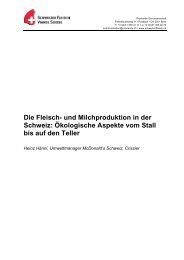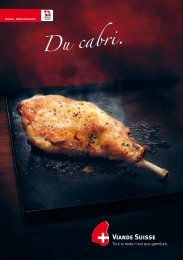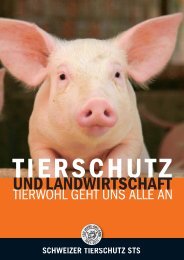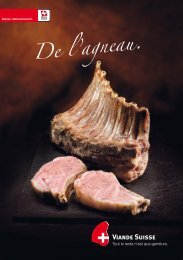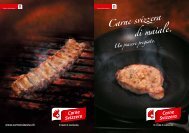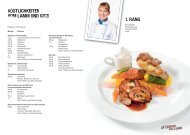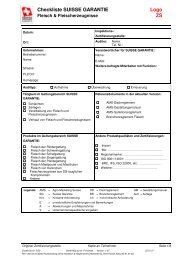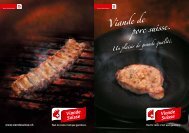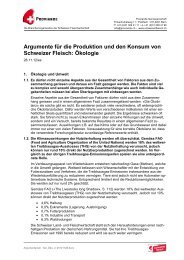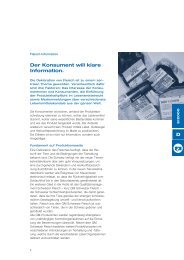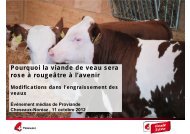Le marché de la viande - Schweizer Fleisch
Le marché de la viande - Schweizer Fleisch
Le marché de la viande - Schweizer Fleisch
Create successful ePaper yourself
Turn your PDF publications into a flip-book with our unique Google optimized e-Paper software.
4 Aussenhan<strong>de</strong>l 4 Commerce<br />
extérieur<br />
4.1 Übersicht Zollkontingente<br />
4.1.1 Importzollkontingente<br />
Um die Importmöglichkeiten in die Schweiz gemäss<br />
<strong>de</strong>n WTO-Verträgen zu gewährleisten, sind Zollkontingente<br />
festgelegt. Für <strong>de</strong>n <strong>Fleisch</strong>import sind dies<br />
die Kontingente Nr. 5(«rotes <strong>Fleisch</strong>», auf Raufutterbasis<br />
produziert) und Nr. 6(«weisses <strong>Fleisch</strong>»,<br />
auf Kraftfutterbasis produziert). Sie haben einen<br />
Umfang von 22500 Tonnen beziehungsweise<br />
54500 Tonnen brutto und sind aufgeteilt in Teilkontingente.<br />
Die Verteilung erfolgt vorwiegend im Versteigerungsverfahren.<br />
Im Rahmen <strong>de</strong>s bi<strong>la</strong>teralen<br />
Abkommens von 1999 gesteht die Schweiz zu<strong>de</strong>m<br />
<strong>de</strong>r EG zwei präferenzielle Zollkontingente zu. Es<br />
sind dies die Zollkontingente Nr. 101 (Schinken und<br />
Teile davon) mit 1100 Tonnen brutto und Nr. 102<br />
(<strong>Fleisch</strong> von Tieren <strong>de</strong>r Rindviehgattung, getrocknet)<br />
im Umfang von 220 Tonnen brutto. Für Importe<br />
von Wurstwaren besteht zu<strong>de</strong>m seit <strong>de</strong>m 1.1.2008<br />
ein präferenzielles Nullzollkontinent (Nr. 301) von<br />
3715 Tonnen netto zugunsten <strong>de</strong>r EG.<br />
4.1.2 Exportzollkontingente<br />
Als Gegenleistung für das Wurstwarenzollkontingent<br />
zugunsten <strong>de</strong>r EG erhielt die Schweiz ebenfalls<br />
ein Nullzollkontingent für Wurstwaren von 1900<br />
Tonnen netto (Nr. 09.4180). Zu<strong>de</strong>m wur<strong>de</strong> im Rahmen<br />
<strong>de</strong>s Abkommens von 1999 ein zollfreies Importkontingent<br />
für getrocknetes <strong>Fleisch</strong> von Rin<strong>de</strong>rn<br />
(ohne Knochen) von netto 1200 Tonnen (Nr.<br />
09.4202) geschaffen. Um dieses Kontingent nutzen<br />
zu können, muss <strong>de</strong>r Nachweis erbracht wer<strong>de</strong>n,<br />
dass das Rohmaterial aus <strong>de</strong>m paneuropäischen<br />
Raum 11 stammt. Daneben besteht auch ein Zollfreikontingent<br />
von 20 Tonnen Trockenfleisch im Rahmen<br />
<strong>de</strong>s Freihan<strong>de</strong>lsabkommens zwischen <strong>de</strong>n<br />
EFTA-Staaten 12 und <strong>de</strong>n Staaten <strong>de</strong>r Südafrikanischen<br />
Zollunion (SACU 13 ).<br />
11 Der paneuropäische Raum umfasst die EU mit ihren 25 Mitgliedstaaten<br />
sowie die Län<strong>de</strong>r Is<strong>la</strong>nd, Norwegen, Liechtenstein, Rumänien, Bulgarien,<br />
Türkei und die Schweiz.<br />
12 European Free Tra<strong>de</strong> Association: Is<strong>la</strong>nd, Norwegen, Schweiz und<br />
Liechtenstein<br />
13 Southern African Customs Union (Südafrikanische Zollunion): Zusammenschluss<br />
<strong>de</strong>r Staaten Südafrika, Swasi<strong>la</strong>nd, <strong>Le</strong>sotho, Botsuana und<br />
Namibia auf <strong>de</strong>r Grund<strong>la</strong>ge eines gemeinsamen Zol<strong>la</strong>bkommens<br />
4.1 Vue d’ensemble<br />
<strong>de</strong>s contingents tarifaires<br />
4.1.1 Contingents tarifaires<br />
d’importation<br />
Des contingents tarifaires ont été fixés afin <strong>de</strong> garantir<br />
les possibilités d’importation en Suisse<br />
conformément aux conventions <strong>de</strong> l’OMC. Pour<br />
l’importation <strong>de</strong> vian<strong>de</strong>, il s’agit <strong>de</strong>s contingents<br />
n° 5 («Vian<strong>de</strong> rouge», produite à base <strong>de</strong> fourrage<br />
grossier) et n° 6 («Vian<strong>de</strong> b<strong>la</strong>nche», produite à base<br />
d’aliments concentrés). Ces contingents représentent<br />
respectivement 22 500 et 54 500 tonnes brutes,<br />
et sont divisés en contingents partiels. La répartition<br />
s’effectue principalement dans le processus d’adjudication.<br />
Dans le cadre <strong>de</strong> l’accord bi<strong>la</strong>téral <strong>de</strong><br />
1999, <strong>la</strong> Suisse octroie en outre à <strong>la</strong> CE <strong>de</strong>ux contingents<br />
tarifaires préférentiels: les contingents tarifaires<br />
n° 101 (Jambons et leurs morceaux), <strong>de</strong> 1100<br />
tonnes brutes, et n° 102 (Vian<strong>de</strong>s séchées <strong>de</strong> l’espèce<br />
bovine), <strong>de</strong> 220 tonnes brutes. Pour les importations<br />
<strong>de</strong> produits <strong>de</strong> charcuterie, il existe en outre<br />
<strong>de</strong>puis le 1.1.2008 un contingent tarifaire à droit<br />
zéro préférentiel (n° 301) <strong>de</strong> 3715 tonnes nettes en<br />
faveur <strong>de</strong> <strong>la</strong> CE.<br />
4.1.2 Contingents tarifaires d’exportation<br />
En contrepartie du contingent tarifaire «Produits <strong>de</strong><br />
charcuterie» en faveur <strong>de</strong> <strong>la</strong> CE, <strong>la</strong> Suisse a également<br />
obtenu un contingent tarifaire à droit zéro pour<br />
les produits <strong>de</strong> charcuterie <strong>de</strong> 1900 tonnes nettes<br />
(n° 09.4180). De plus, dans le cadre <strong>de</strong> l’accord <strong>de</strong><br />
1999, un contingent d’importation en franchise <strong>de</strong><br />
droits <strong>de</strong> douane pour <strong>la</strong> vian<strong>de</strong> séchée <strong>de</strong> génisses<br />
(sans os) <strong>de</strong> 1200 tonnes nettes (n° 09.4202) a été<br />
créé. Pour pouvoir utiliser ce contingent, il faut apporter<br />
<strong>la</strong> preuve que les matières premières proviennent<br />
<strong>de</strong> <strong>la</strong> zone pan-européenne 11 . En parallèle,<br />
il existe aussi un contingent exempt <strong>de</strong> droits <strong>de</strong><br />
douane <strong>de</strong> 20 tonnes <strong>de</strong> vian<strong>de</strong> séchée dans le<br />
cadre <strong>de</strong> l’accord <strong>de</strong> libre échange conclu entre les<br />
Etats <strong>de</strong> l’AELE 12 et les Etats <strong>de</strong> l’Union douanière<br />
d’Afrique australe (SACU 13 ).<br />
11 La zone pan-européenne comprend l’UE et ses 25 Etats membres, ainsi<br />
que l’Is<strong>la</strong>n<strong>de</strong>, <strong>la</strong> Norvège, le Liechtenstein, <strong>la</strong> Roumanie, <strong>la</strong> Bulgarie, <strong>la</strong><br />
Turquie et <strong>la</strong> Suisse.<br />
12 European Free Tra<strong>de</strong> Association (Association Européenne <strong>de</strong> Libre<br />
Echange): Is<strong>la</strong>n<strong>de</strong>, Norvège, Suisse et Liechtenstein<br />
13 Southern African Customs Union (Union douanière d’Afrique australe):<br />
groupement <strong>de</strong>s Etats Afrique du Sud, du Swazi<strong>la</strong>nd, du <strong>Le</strong>sotho, du<br />
Botswana et <strong>de</strong> <strong>la</strong> Namibie sur <strong>la</strong> base d’un accord douanier commun<br />
38



